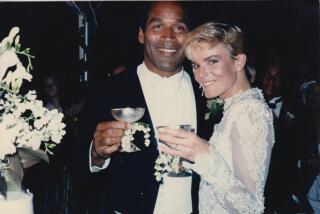PERSPECTIVE ON THE NEW YORKER : An Institution Gone to the Dogs : The icon of American writing finally deflates itself with a 16-page photo spread (no prose) on the Simpson trial.
- Share via
Tina Brown hasn’t changed the New Yorker, she has obliterated it. There is still a magazine, just as there is still a place in Manhattan called Penn Station, but nobody confuses it with the old one. And now, this past week--the April Fool’s Day edition--you opened the magazine to a portfolio of Annie Leibowitz photos of the O.J. Simpson trial and its inhabitants and you heard the whoosh of an American institution suddenly getting smaller.
Sixteen--count ‘em, 16--pages, including one devoted to the late Nicole Simpson’s dog and one of Kato Kaelin blow-drying his hair and one of O.J.’s girlfriend lying on her back with her shirt unbuttoned. It’s nuts; Americans don’t buy the New Yorker so they can see this stuff, just as we don’t go to Rome to eat at Burger King.
Once the New Yorker was meant to be read; now it is only meant to be talked about.
Question: Did you see the pictures of the Simpson trial in the New Yorker?
Answer: No.
Q: Oh.
A: Who took them?
Q: Annie Leibowitz.
A: Oh.
Maybe that’s what you call “buzz,” the zap of momentary immortality. But when America’s most famous photographer of celebrities goes to photograph America’s most famous celebrity murder trial shown daily on a television set near you, what exactly is new? The expression on Simpson’s face in a Leibowitz photograph is pretty much what it’s been for months in the daily news. Where’s the buzz?
Maybe it’s a Hollywood thrill, the thrill of the deal--”Leibowitz Inks Pact to Shoot O.J.”--but if all the buzz is in the concept and the product turns out to be banal, as these Leibowitz pictures are, what do you do for a second act? Do you photograph Simpson’s lunch? Do you send for Matt Groening? Do you print photographs of bare torsos of Simpson trial participants as shot by Chuck Berry, with captions by Sen. Alan Simpson? People surely will talk about it if you do, but is this really what the New Yorker is about?
The magazine it used to be was a remarkable piece of work, full of surprises, a magazine that rewarded your close attention with jewels of wit and precision.
Some people considered the magazine elitist because it published a few writers who wrote better than anybody else in the world, but great writing is truly democratic, open to all--what’s really snooty is to put out commercial garbage for an audience that you yourself feel superior to.
The New Yorker gave writers lavish freedom to write about what engaged their curiosity and to let the piece find its own tone and length and take its own route. You’d open an issue and start reading an article about canoe-making or Kansas City barbecue joints or Pella, Iowa, or a baseball scout, and though you wouldn’t have bought the magazine for that article, you got absorbed in it, you read it avidly, you savored it and it stuck with you for awhile. This is no longer true. Today, sadly, the New Yorker is all in the packaging.
If some ditzy American editor went to London, took over the Spectator and turned it into, say, In Your Face: A Magazine of Mucus, there would be a big uproar, but here in America, we expect turnover. Here, a great American magazine falls into the clutches of a Staten Island newspaper mogul who goes out and hires a British editor who seems to know this country mainly from television and movies, and nobody says much about it.
That’s a sign of the frontier vitality of American culture. We believe that if the New Yorker becomes People today and Parade next week and Power Boats & Launches by summer, well, too bad. The readers who once read it will find something better, and the force that drove all those beautiful writers to make the New Yorker what it was for so long will simply find another route to the sea. So long, Mr. Shawn, and good night, E.B. White.
More to Read
Sign up for our Book Club newsletter
Get the latest news, events and more from the Los Angeles Times Book Club, and help us get L.A. reading and talking.
You may occasionally receive promotional content from the Los Angeles Times.







